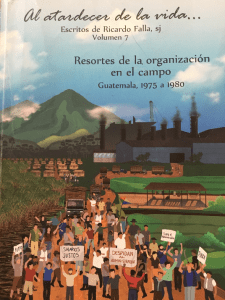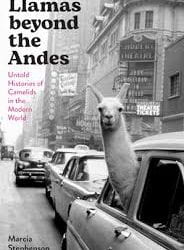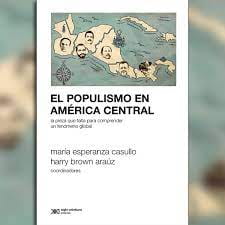A Review of Resortes de la organización en el campo, Guatemala 1975 a 1989
One of Guatemala’s most illustrious thinkers and activists, Ricardo Falla, SJ, has lived through considerable historical transformations, including his own. Born in Guatemala in 1932 into a well-to-do family of plantation owners, he joined the Jesuits in 1951 and studied theology in the 1960s in Innsbruck, Austria. One summer during his stay in Europe, encouraged by a worker priest, he worked alongside Spanish immigrants in road construction. Accustomed to riding comfortably in an expensive car and seeing men digging ditches or repairing potholes, now suddenly he was one of them. This encounter of even temporarily experiencing the hard labor of the working class led him to experience a shift to the workers’ perspective that offered him “una nueva opción que me lleva a los pobres.”—a new option for the poor (p.12) He became immersed in liberation theology, studied anthropology at the University of Texas, and wrote Quiché Rebeldé, a path- breaking book on religious conversion among Mayas in San Antonio Illotenango, Quiché, in Guatemala.
Amid all this, he and other like-minded Jesuits formed a team dedicated to “direct action and social research, whether in the field or the library.” They set up household in a poor neighborhood of Guatemala City, drawing young people, “full of energy and ideals” into their style of research and action. ( p. 2) This was the foundational space for his life as an anthropologist and priest who has written prodigiously about the people whom he has accompanied since the 1970s. Whether in refugee camps in Mexico, or in the Comunidades del población en resistancia (CPR) in Guatemala, Falla has been entrenched in figuring out how poor people can angle the wheel of history to turn it in their favor.
An intellectual working outside of academia, he has raised the stakes on the production of knowledge in multiple ways. He presents to us several profoundly thought-provoking challenges. One is that knowledge be constructed by collectives of people, rather than by individuals, who plan research based on their questions, carry it out and reflect on it as a group. A second is that this production give priority to experience, including of subjectivities, over theories, without rejecting all of these. The writings of Scottish anthropologist Victor Turner, Spanish sociologist Manuel Castells, Brazilian educator Paolo Freire and German philosopher Karl Marx have all provided theoretical frameworks. A third of his challenges is that research revolve around emancipatory social change. His tenet is straightforward enough: “research is to achieve liberation..” (“la investigación es para la liberación.”) ( p. 38)
A Review of Resortes de la organización en el campo, Guatemala 1975 a 1980 by Ricardo Falla, SJ, (Guatemala: AVANCSO, Universidad Rafael Landívar and Editorial la Universidad de San Carlos, pp.715)
Most of Resortes is about locating the multiple ideological and material springboards that would make organizing rural workers possible in the 1970s. Each proceeded by a “Refleccion de Hoy” written in 2019, sixteen texts divided into three sections, and a Coda make up Resortes. The topic of the first, “Buscando la Alianza Costa-Altiplano,” discusses the potential for an alliance between seasonal Maya workers from the highlands and the ladino permanent labor force on the southern coastal plantations. The second, “Invisiblemente entra al organización revolucionaria,” evaluates the role of the left on the coast. The third, “Del norte de Guatemala nos viene una avalancha” takes a different track. It consists of an account of the Ejército Guerrillero de los Pobres’ (EGP) occupation of the town of Nebaj, as well as fieldnotes on the Northern Transversal Strip, site of extractive industries and emerging conflicts over land.
The Coda, “A modo de conclusión: Clímax de la Organización,” appears as the denouement to most of these texts. It is from De Sol a Sol, the newspaper put out by the Comité de Unidad Campesina ( CUC). It captures the remarkable achievement of the sought-after alliance: the 1980 CUC led strike that united 80,00 coastal ladino and highland Maya rural workers and their families who, armed with machetes, paralyzed the coastal plantations of sugar and cotton at the heart of the national economy, held off a full-blown military assault for fifteen days and forced the government to raise the national minimum wage from two to five quetzales, a huge win. It was unprecedented in its unity, national vision, militancy and success. The excerpt was edited in 2019 so that the spirited last line of Resortes reads, “Let’s seize power so we can build an equitable society” “(…tomemos el poder y construyamos una sociedad justa.”
Making good on “research is for the purpose of liberation” most of the notes and micro- ethnographies that comprise Resortes need to be understood from the perspective of an anthropology of liberation that, unlike most anthropology, tries to use its findings to foster mobilization against oppression. They generally follow the pattern of “presenting ordinary ethnographic material, and then placing it in the context of the question of the moment.” (p. 14) Falla and his team gathered extensive information—the work of “ordinary” ethnography—on demographics, labor, social relationships, stratification, land tenure, ritual, religion, local history and memories, ongoing conflicts and existing organizations. They used this information gathering to identify the obstacles to and possibilities of building the highland-coastal alliance— the question of the moment.
Broadly speaking, in the mid-1970s they found more obstacles to those alliances than possibilities for them. One of these was the fragmentation of the plantation labor force. It was basically split between ladino permanent workers and teams of Maya seasonal workers that in turn each lacked internal unity. The first group was divided by the differing concerns of the rancheros residing inside the plantations, and the voluntarios, the wage workers who lived outside it. Falla observed that even the Maya migrant workers who—though housed together and working side by side— hailed from different linguistic areas, and from villages that did not necessarily get along. In addition, Falla noted they were more interested in their home communities and alternatives to seasonal migration through “Green Revolution” programs than in improving coastal labor conditions. Organizing through unions and legal means in the 1970s, the secular left could not win in the courts or patch together these disparate parts. In one telling example, the left could not get around the basic problem that the rancheros had organized the union to the exclusion of the Maya seasonal workers and the voluntarios.
Radical clergy had a different approach to organizing. Their pastoral work started at the community level, and not in the workplace; rather than developing unions, it focused on building Communidades de Base. (CEBs). These CEBs were part of the bold project of creating an ” A New Church”in which identity would be based on a local community formed on the basis of “friendship, knowledge and mutual support,” “instead of one centered on church attendance of people who did not know one another, and who, hailing from positions of power and powerlessness, had opposing class interests.” ( p.435)
In one of the most powerful pieces in Resortes, “La Iglesia en Tiquisate,” Falla describes a CEB in a particularly fertile area of the southern coast with its vivid memories of the possibilities offered by the land reform and the successful strikes against the United Fruit Company in the 1944-1954 period. Those who had participated in this era of social effervescence and their offspring were among this CEB’s most consistent participants. The pastoral work there emphasized inclusive actions that emanated from immediate concerns of the entire community, and not sections of it. This CEB successfully set up a medical center (mainly through the efforts of CEB women), mobilized to prevent the destruction of nearby mangroves and to stop the chemical fumigation that affected the area. Using a discourse that pulled together aspects of both Marxism and Christianity, and explicitly referencing love as a revolutionary force, the CEBs offered a moral conscience of the common good that simultaneously embraced class consciousness. Towards the end of 1977 and thereafter state violence that explicitly targeted radical clergy and lay workers all over the country slashed this growth of the CEB into ribbons.
By then things were moving very rapidly. The sheer destruction caused by the 1976 earthquake and the appalling corruption involved in the state’s so-called reconstruction efforts sharpened political awareness, including of the need for unity. It made even more egregious a poverty that was swollen by the raising prices of synthetic fertilizers that doomed the Green Revolution and forced many Mayas back to plantation labor. In response to growing discontent, the varying degrees of state and elite repression that had been a constant since 1954 started to escalate to unprecedented heights. In the face of the bombings of highlands, the massacre of villagers in Panzós trying to protect land rights, increased disappearances, and the relentless legal and extra-legal means through which the elite and the state tried to stop every single attempt at social change, no matter how small, what could one do?
CUC’s emergence in 1978 was a step towards armed struggle. A convergence of clergy, lay workers, EGP cadre and Maya members of both the Asociación Pro Cultura Maya-Quiché and the radicalized Acción Católica, it advocated direct action. In its transcendence of the exhausted organizational forms of unions and peasant leagues, and the frustrations with legal means, it spoke to the moment. Perhaps needless to say, it built on decades of conscientization and experiences in conflict.
In addition to the Coda, Resortes has two short selections on CUC. One is a comprehensive outline of a course written by Falla and other Jesuits in 1978, “Cursillo fundacional del CUC,” seeking to bring local leaders from the coast together with those from the highlands in a pleasant atmosphere. The aim was that they, the people best suited, figure out how to really build an alliance. The outline details times for classes, meals, songs, theatre, slide shows, and it itemizes materials required. The lesson plan was loosely based on Freire’s method: the facilitator would solicit knowledge about oppression and liberation from the oppressed with seemingly simple questions such as ” What types of exploitation are there in your area? What are life’s necessities there?” and “What can be done to ” solve all this? ” (p. 501) In not being proscriptive, it represented a radical break from the methods of the vanguard leftist parties.
The second, De Sol a Sol, “Evaluación del periódico,” is Falla’s record of a meeting in 1977 of a few Jesuits and members of the EGP who had left the Jesuit Order. De Sol y Sol was a key tool that was distributed to parishes by lay workers and clergy, including an evangelical pastor. Falla’s notes include numbers and places—500 to Escuintla, 300 to one subdivision in Suchitepéquez and so forth. At eight mimeographed pages, its cartoons, colloquialisms, and clear reporting did the crucial work of engendering a new discourse of a “we,” the oppressed who worked from sunrise to sunset, whether Maya, ladino, male, female, elder or child, a varied group which if bound together without each losing its specificity could form an emancipatory political subject.
Their evaluation of De Sol a Sol basically circled without conclusion around the critical question of whether the paper should openly support armed revolution or, alternatively, remain open to that possibility without advocating it. Falla gives a useful example of what this came down to. De Sol y Sol reported on the strong popular resistance to the military’s forced recruitment. Should De Sol y Sol position that opposition as a human rights issue or as part of the revolutionary struggle? This soon became a moot point. Following the 1980 strike, the climate of repression made it impossible to sustain De Sol y Sol or the character of CUC as an open mass organization. Some members of CUC withdrew from activism and others went to the mountains to join the EGP or other armed groups.
“La Toma de Nebaj” in the third section of Resortes gives the reader a snapshot look at the EGP at that moment in its development. Falla transcribed a Nebajeña/o’s eyewitness account of the 1979 EGP’s take-over of Nebaj, an Ixil town in Quiché. To briefly sum up the narrative Falla wrote down: many Nebajeña/os were among the one hundred mainly indigenous guerrilleros dressed in green uniforms who arrived at 6 a.m. and blocked Nebaj’s entrances, summoning residents to the central plaza. Four EGP members, including one Maya woman, addressed more than 2,000 people in Ixil and Spanish to announce that the EGP was everywhere and would liberate Guatemala. People responded with sympathy, food and drink. In the early afternoon the guerrilleros left as they had come, in good order, without having disturbed anything.
This event electrified the highlands. It presented an EGP that appeared to be militarily competent, orderly and politically self-confidant. It had, Falla writes, magic. The presence of a Maya woman in a commanding role is a significant detail in an episode that stands as the affirmation of Mayas part in the EGP. What happened in the following months and years is another history.
Obviously, all of Falla’s “Introducción de hoy“ were written after the genocide. Falla cautions against violent solutions and asks about other possible means. He suggests that under EGP influence, CUC encouraged a move towards armed struggle following the 1980 strike that led to the devaluing of Guatemala’s first inclusive grassroots mass organization. The suggestion here is that a larger popular movement needed more time to become deeply political and, in that process, make possible an insurrection further down the line. Instead, in the euphoria generated by the Sandinista Revolution and its own conceit, the EGP pushed hard for an immediate seizure of power, the quick military win for which, as events would tragically show, it was not prepared. Falla frames his criticism of triumphalism by underscoring that events such as the takeover of Nebaj and the 1980 strike need be remembered as the triumphs that they were in themselves. To dismiss these in view of the military’s ultimate success would “disappear” the truths that a highland coastal alliance and Maya leadership of a national revolution are historical possibilities, not fantasies.
Falla recognizes that the defeat of the movement, the deaths, disappearances or exile of generations upon generations of Guatemalans since 1954, and the loss of more than 150,000 primarily Maya lives in the 1980s can give way to the crippling logic of despair and cynicism. He confronts this with an almost dark optimism. In the Introducción de hoy for the article “La Iglesia en Tiquisate,” he writes proudly of his many friends who were murdered because they tried to bring the reign of God to earth. With emotion, he asks himself whether all the deaths were worth this struggle. He replies’ Was everything lost? We do not believe that it has all disappeared.’ if the grain does not die, it cannot live’“(“se perdio todo? No crearemos que todo haya desaparecido. ‘El grano de trigo, si no muere, no vive’.”)
Even through the Guatemalan military won the war, it is not predetermined that it wins the future. Today thousands persist in pushing forward the unpredictable and unfinished history of emancipation in their fight to protect land, the environment, the frail legal system, women’s bodies, university autonomy and more, including the ideals of those who died so that others might live.
Deborah T. Levenson is the author of numerous books and articles on Guatemala. Her most recent book is Adios Nino, The Gangs of Guatemala and the Politics of Death. She is professor emerita from Boston College.
Related Articles
A Review of Llamas beyond the Andes: Untold Histories of Camelids in the Modern World
Marcia Stephenson’s Llamas beyond the Andes is about humans making use of another animal. With a dustjacket image of Llinda Llee Llama riding in the back of an automobile in mid-20th-century Times Square, this book illustrates how sentient nature has been engulfed by human cultural objectives since Columbus’ arrival in the Americas and the rise of Europe’s global imperial ventures. The window on all this is American camelids: llamas, alpacas and their wild relations, guanacos and vicuñas.
A Review of Born in Blood and Fire
The fourth edition of Born in Blood and Fire is a concise yet comprehensive account of the intriguing history of Latin America and will be followed this year by a fifth edition.
A Review of El populismo en América Latina. La pieza que falta para comprender un fenómeno global
In 1946, during a campaign event in Argentina, then-candidate for president Juan Domingo Perón formulated a slogan, “Braden or Perón,” with which he could effectively discredit his opponents and position himself as a defender of national dignity against a foreign power.




